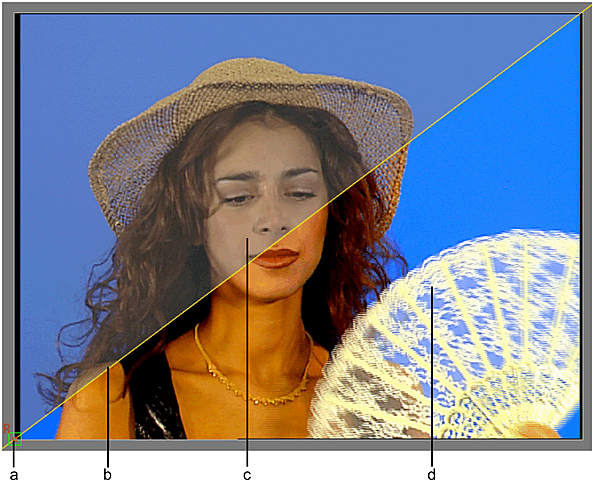Comparing a Clip to a Reference
In the image window of the tools that support multiple viewports, you can compare the currently displayed clip to a reference. The reference can be one of the current tool's working clips (for example, front, back, or matte), or one of the reference frames that you grab on-the-fly.
Comparing to a Reference
To compare the viewport to a reference:
- Display the image in a viewport.
- From the Compare Modes box, select an option.
- From the Reference box, select a reference. This can be a reference you grabbed, or another view available from the Effects or Batch tabs.
- Grabbed references are grouped under Grabbed References.
- Context views are grouped under Context Views.
- Other available views, such as Font/Back/Matte can also be listed, depending from where you are displaying the viewport.
To change the settings for a comparison mode:
- From the Compare Modes box, select Edit Compare Modes.
- In the Edit Compare Modes, select a comparison mode.
- Edit the settings.
Grabbing a Reference
Grabbed references are stored in the Grabbed References library, a new special library in the Media Panel. You can rename, sort, delete references from the Grabbed References library. Grabbed references, being stored in a library, are archived when you archive the project.
To grab a frame:
- Display the frame to grab in the viewport.
- Grab the frame with one of the following:
Press Ctrl+G to grab the frame and name it.
Press Ctrl+Shift+G to grab the frame without naming it. Flame automatically names it Reference <#>.
From the Reference box, select Grab.

To display the grabbed references:
Enable the preference General
 Media Panel
Media Panel  Show Grabbed References.
Show Grabbed References.The Grabbed References library in now available in the Media Panel.
Note: The Effects tab does not display the contents of the Grabbed References. You can still use the Reference box to select a reference to compare to. Or cycle through the grabbed references.
To cycle through the grabbed references:
- Press and hold Ctrl+NUM5 to display the reference overlay.
- While holding Ctrl, press NUM4 and NUM6 to cycle backwards and forwards through all stored reference frames.
Available Keyboard Shortcuts
Here is a list of keyboard shortcuts available for you to use, or define if need be.
To select a comparison mode:
- Compare / Stereo: Select Blend Mode
- Compare / Stereo: Select Difference Mode
- Compare / Stereo: Select Angle Split Mode
- Compare / Stereo: Select Grid Mode
For the following keyboard shortcuts, make sure to select the related comparison mode to be able to set these.
To edit compare modes directly from the viewport without resorting to the Edit Compare Modes window:
- Blend mode: Blend Factor: Shift+T+ drag.
- Grid mode: Grid size: Shift+T+ drag.
- Difference mode:
- Difference Clamp
- Difference Min Clamp: Shift+Y+drag
- Difference Max Clamp: Shift+U+drag
- Difference Lift
- Difference Gain: Shift+T+drag
To cycle through compare modes:
- Compare: Cycle through Compare Modes. The Compare Off option is not part of the cycling.
- Compare: Toggle between Compare Off / Previous Select Mode shortcut can be used to toggle enable / disable the Compare.
Using the Split Bar
You display the split bar by selecting the Angle Split option from the Compare Modes box.
The split bar has a pivot point (indicated by a small box) around which the split bar can be rotated, or from which the split bar can be moved. The letter R next to the pivot box indicates the side of the bar where the reference clip is displayed.

(a) Pivot point (b) Split bar (c) Current display (d) Reference display
Rotate and move the split bar using these techniques:
- To rotate the split bar around its pivot point, drag the split bar.
- To move the split bar, drag the pivot point. You can also Ctrl+Alt-click the image to place the pivot point under the cursor, and then drag over the image to move the split bar.
- To restore the split bar to its default position, Ctrl-click the pivot point.
Showing and Hiding the Split Bar
When the split bar is on, you can show or hide it in the image window.
To show or hide the split bar:
Ctrl-click the split bar.
When the split bar is hidden, it is still active. The letter R is displayed indicating the location of the reference clip.
